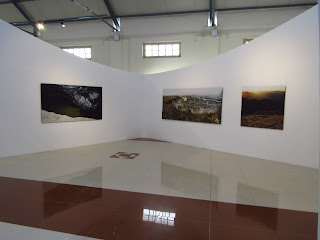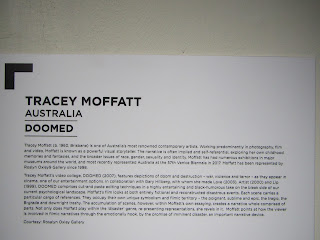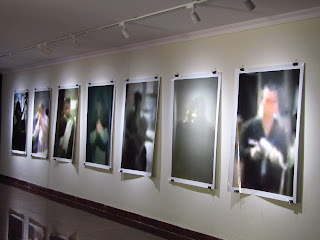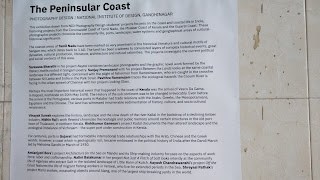An Introduction to CPB II (2019)
A Biennale is a festival that occurs once every two years. The Chennai Photo Biennale, therefore, is very straightforward in its name. But in nothing else.The Chennai Photo Biennale (or CPB as it is referred to), went on from 23rd Feb to 24th March of 2019, with 50 artists participating at 15 venues. The opening ceremony was presided over by, apart from the CPB curator, and founders, the Culture Minister, 'MaFoi' Pandiarajan, the Vice-Chancellor of Madras University, an IAS officer, and Mukund Padmanabhan, the past editor of The Hindu. The ceremony happened in front of the senate house. This was apparently a second edition, a revelation to even Chennai citizens who had hardly heard of the first.
One thing that amused me was that anyone associated with a venue,whether it be MLS volunteers with MLS, or Cholamandal residents with Cholamandal, or Artists with Gallery Veda or the Government college, all said that that particular venue was the best. To each their own, I guess.
As this was a Photo exhibition, I will fill this with photos. I will not be going in chronological order, as I visited some venues multiple times, but will go venue by venue, starting of course, with Senate hall.
(Most photos are self-explanatory, so captions have been used only where needed)
SENATE HALL
This huge stately building was restored painstakingly by INTACH 10 years ago - and in the meanwhile has been left to fall into ruin. Built in 1879 by Robert Chisolm, in the oh-so-popular Indo-saracenic style, it was used for graduation ceremonies of the University, and in fact, when the first Congress government was formed in Madras in 1937, they met here. Nowadays, it is used to store exam papers. Even after CPB patched it up a bit, the walls were flaking, the ceiling was torn in places, and some floorboards sagged or were inclined upward.CPB has displayed 4 exhibitions on the main hall, one in the tower at the back, and 5 more on the first floor.
The title at each venue is taken from a book or movie, and all the exhibits there go around that theme. The overall theme for the Biennale was Fauna of mirrors. You can read more about that here. The theme at senate house was Labyrinths.
The first display, made to honour the fishing community, that had been displaced during colonial time, broke the size of the building, and took your gaze straight there. Navigating the 'labyrinth' within, you came to a reading room, with various photo books. At the end of the room, was a carpet, made of photos - which was not as it seemed.
Up the tower at the back, was The Hindu's display, with photos from their archive, put together by an artist group from Mumbai. Each cut-out image connected to the next through a theme, which changed after every few picture, but in an organic way.
On the first floor, there was a display on Kashmir, that was extremely moving, a set-up with photos and tools used by mortuary workers, that highlighted how unsanitary and the terrible set-up of our city's morgue. Another display had a slow video of a workroom, where your perception of what went on in there slowly changed. Another had a set of photos projected onto a screen. And the last another video, that i did not see too closely.
Like most others, I was more taken in by the building, and photographing it, than the exhibits themselves, except in certain places.
The carpet that hides more than it shows
The Hindu exhibit from the other side
The stairs to the tower
The exhibit on Kashmir
GOVERNMENT COLLEGE OF ARTS, EGMORE
The government college of fine arts is the oldest art college in India, started in 1850 and coincidentally, it is where the Photographic Society of Madras started in 1857(The Second oldest photgraphic society in the world, and also displaying in CPB II). The arts college had 3 buildings housing exhibits. The main hall had P Sainaths work, which was heavily text oriented, behind which there were many artists showing. The theme in this hall was 'An unbearable lightness of being', and in another section, 'The Architecture Story' . One exhibit had farmers(wives mostly, sometimes husbands and daughters) hold photographs of family members who had committed suicide, with the amount of debt owed next to them- the number that killed them. One exhibit had photos of the Sher-gill family merged, and cropped with their works, centred around Amrita Sher-Gill, created by her nephew, Vivaan Sundaram.
P Sainaths exhibition
Video/photo collage of the Sher-Gill family
The Roy Chowdary art gallery had exhibits pertaining to violence. The theme was 'Fractured'. One Lebanese photographer had selected and curated stills from videos taken during the Syrian war. He had a video playing that talked about death and its connection to the Syrian war. On the other side was a video by an American artist where she documented violent visuals in movies, and created a movie out of all of them.
Rabih's stills from the phone videos
Finally, the museum in the college had been emptied of its exhibits, and in its place were photos by 3 artists, all of which challenged norms in some way. Here the theme was 'The Face of another'. One artist had challenged the idea of photography by photoshopping icons in the place of her torso. A Korean photographer had challenged the stereotype of 'the orient' with a series of pictures, and then there was a series of photos of women who challenged the tradional role of women with regard to society. Some were power lifters. Some Bharathanatyam dancers. Each had their own unqiue combination of interests and occupations.

The photos of women sit in the glass display cases by the side
MLS
The Madras Literary Society had 3 exhibits. Each exhibition here was associated with books in some way. The theme, of course, was, 'The Library of Babel' . In front was an Indonesian artist who had documented a traveling librarian, his pony, and his moving library, in Borneo. Inside the library, two tables had been set up with books, both by Angela Grauerholz. One book had pictures of empty shelves. The other, titled 'privation', was from 2001, and was on her library which burned down. The photos are of burnt books. In the reading room at the back, Liz Fernando had set up pictures from a century or so back, that had faded, or were damaged. They had been reprinted on rice paper, and displayed, some hanging in the windows to let the light shine through them. Some antique furniture of MLS's complemented Liz's work.
Angela's books
Some of Putu Sayogas displays
A part of Liz Fernandos exhibit in the reading room
CHOLAMANDAL
Munim's work, arranged to look like a continuous landscape
EGMORE MUSEUM
At the Egmore museum the theme was 'Why Look at Animals?' The exhibit was at the back, in and around the centenary hall. However, signage was poor, though I heard of CPB going back again and again to put it up.
At the museum, one of the displays was by school children who had caught images on iphones, taken during photo camps. Some of these photos were on display. Most of the photos were by government school students, and had attracted the attention of Apple CEO Tim Cook himself.
The next exhibit was of a few images, created by taking elements from various photos and putting them together to create a surreal composition.
Inside the Centenary hall were two videos by an Australian photographer, one on the gold rush in Western Australia, and the other on the import of camels from Rajastan by the British.
MRTS STATIONS
An empty Kasturba nagar station
At Chinthadripet, Srishti Insititute of Art, Design and Technology had various images on the ground floor, and huge portraits hanging from the first floor, made out of small pixellated dots.
ripped and torn posters
The hanging pixel faces
At Lighthouse, there were faces of various old people, taken by the Shri SS Shasun Jain College for women in T nagar, Chennai.
The deserted station, with two lone volunteers by one side
At Kasturba Nagar(or as the name is now, Kasturibai ) there were photos around the theme of nature, and the interaction of man and nature by NID, Gandhingar.
At Thiruvanmiyur, NIFT had taken various people, working varied jobs, and put them in unrelated scenarios, and taken photos of them. The most interesting piece here had to be the image of the woman that was spread across the stairs, seen as an image only when you viewed it from below.
People coming and going - hardly any looking
GALLERIES
ART HOUZ
The films were:
I swear on my Mother; a 9 minute film on the rise and reign of Jayalalithaa, popularly known as 'Amma', the longest reigning Chief Minister of Tamil Nadu
A film in a set city, where the tour guide makes up a fantastical story of why the town is 'abandoned'
Masterji: "Master Ji’ is a collaboration with choreographer Mark Morris. These images of Saroj Khan, the legendary Bollywood dance choreographer, were made in the early 90s"
(CPB website)
The photo exhibitions included
Photographs of films, where the photographer has taken long exposure shots of movies to create a single image of various movies,
Ravinder Reddy's images from movies of people, capturing various emotions
Cop Shivas images of the man, Vidyasagar in Bangalore who likes to dress up as MGR, film actor turned politician.
A series of images on people and their reactions to films, whether in a theatre, or in an outdoor setting
Jethalal H Thakkers photos of Bollywood stars from the previous century was the only posthumous exhibit in the whole biennale.
FOCUS ART GALLERY
At the back of a spacious, well-lit gallery, was the exhibition of the Photographic Society of Madras(founded 1857).
The members had put up photos pertaining to the city, and its culture. The images were all very simple, with no deep meaning, but full of detail, vibrancy and life.
A reflection
FORUM ART GALLERY
This gallery's exhibiton was titled 'Chariots of Frolic', and documented various vehicles used for weddings across Tamil Nadu. These vahanas would be lit up, and a band would lead the vehicle, with the bride and groom on top, to the wedding, and back home. There was a small film as well, of the backstage work.GALLERY VEDA
Gallery Veda, though not a big exhibit, is considered by most to be one of the best. It consisted of a series of portraits of a certain tribe in the NorthEast, whose lands were taken for mining. The whole gallery was darkened, and navigation was through a miners helmet and light. Background music was the kind one would hear in a forest - small birds, insects and frogs. Faces would loom out of the darkness, and stared down at you.MISSING VENUES
The two galleries I missed were Inko Centre, and Phoenix marketcity. However, I was told that no one was able to find the exhibits at the mall, and that it would be a waste of time, and so left it. I had no time to go see Inko, but was told that it was the work of the Korean artist who had a display in the museum of the Government Arts College.In Conclusion
However, it was not all perfect. At the Chinthadripet station, some of the information signs were torn. Out of 4 MRTS stations, only one(Lighthouse) had volunteers at it when I was there. This was the station that needed volunteers least, as there were such limited exhibits, and the fact that Chinthadripet and Thiruvanmiyur are more popular. At most locations, the CPB volunteers were not too attentive. At one venue, I saw a volunteer randomly click on the counter used to identify how many people come to the venue. One of the volunteers posted at MLS graffiti-ed a table and was caught by the librarian! Some volunteers, like the ones at Lighthouse, however, were very enthusiastic and engaging. The beautiful Senate house, restored a decade ago, and left to fall into ruin, was cleaned by CPB as best as they could. But it is never used for any other events, and will fall into ruin once again if used only for storing exam papers, and unintentionally breed pigeons.
CPB, however, has done a commendable job. Despite whatever criticism there is, it was a fresh experience, and something that Chennai responded to positively. The press was all over it, well in advance. International visitors to the Biennale poured in, the government was supportive, we locals loved it, schools and colleges visited by the busloads and all around, everyone is enthused and ready to bring in an even bigger Edition 3! (Update: Edition 3 has been slated for early 2022)



































































































































































Nicely written Nandan. Too many photos i thought, but like you say, it is all about photography, still, I thought fewer might be better. More power to you. Lots of luck and cheers.
ReplyDeleteThanks
DeleteVery well written...comprehensive coverage of all the venues
ReplyDeleteThanks!
Delete
ReplyDeleteGulberg islamabad is a great venture started by IBECHS. It is situated in the central location of the twin cities making it a goldmine for the aspiring investors. There are two main roads that conjoin at Gulberg greens including Airport road and G.T road